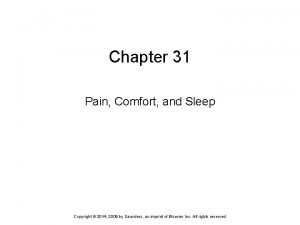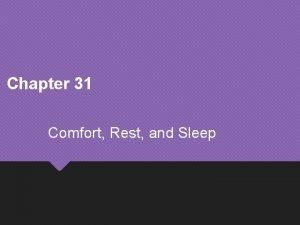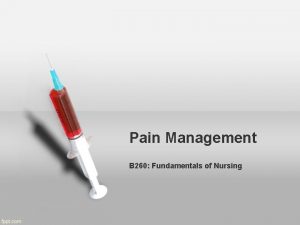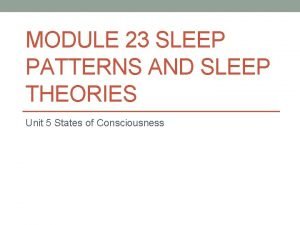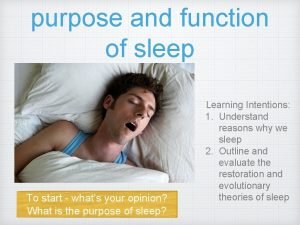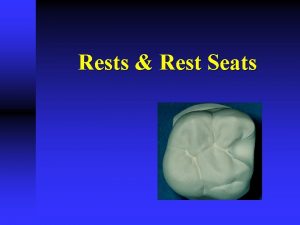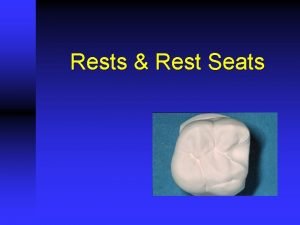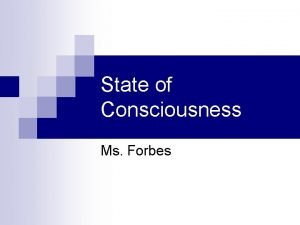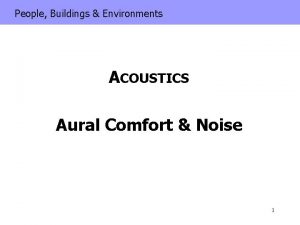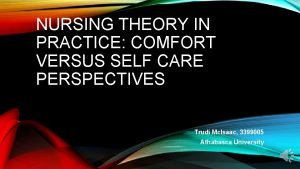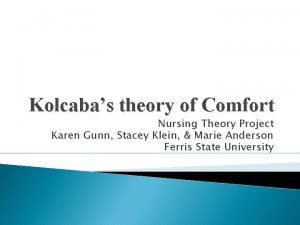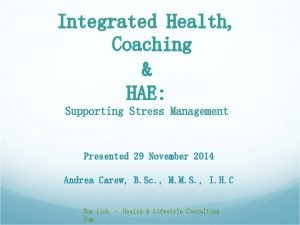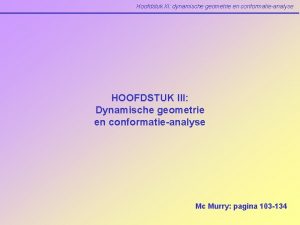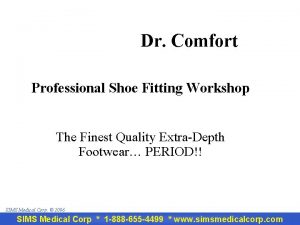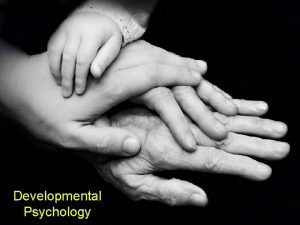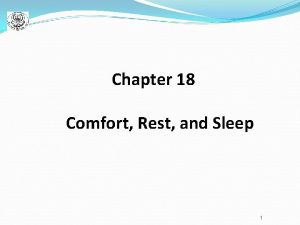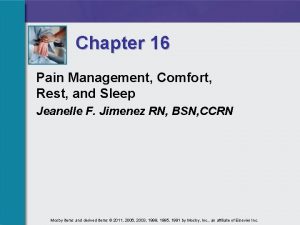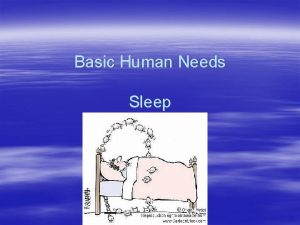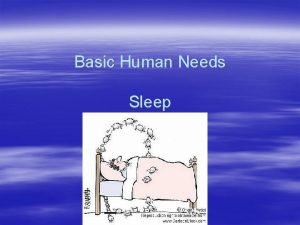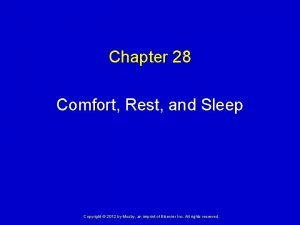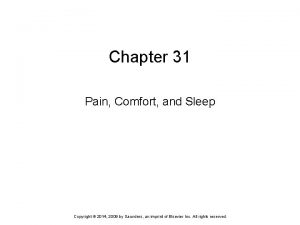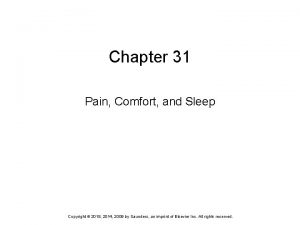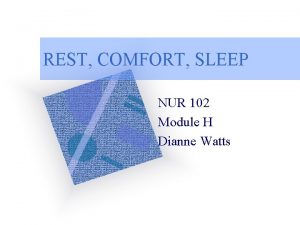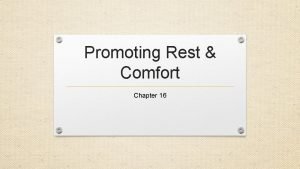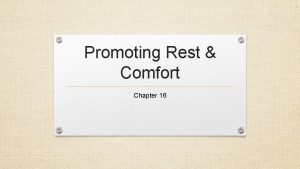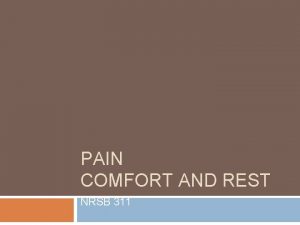Unit 10 Comfort Pain Rest and Sleep Copyright






































- Slides: 38

Unit 10 Comfort, Pain, Rest, and Sleep Copyright © 2008 Delmar Learning. All rights reserved.

Objectives • Spell and define terms. • Explain how loud noise affects patients and hospital staff. • Explain why nursing comfort measures are important to patients’ well-being. Copyright © 2008 Delmar Learning. All rights reserved.

Objectives • List six observations to make and report for patients having pain. • Describe nursing assistant measures to increase comfort and relieve pain. • State the purpose of the pain rating scale and briefly describe how the pain scales are used. Copyright © 2008 Delmar Learning. All rights reserved.

Objectives • List nursing comfort measures that promote rest. • Describe the phases of the sleep cycle and the importance of each. • List nursing measures to promote sleep. Copyright © 2008 Delmar Learning. All rights reserved.

Noise • Excessive noise: – Delays healing – Impairs immune system function – Increases heart rate and blood pressure – Causes patients to feel stressed anxious Copyright © 2008 Delmar Learning. All rights reserved.

Noise • Excessive noise: – Interferes with sleep – May trigger wandering in confused patients – May cause patient dissatisfaction with care Copyright © 2008 Delmar Learning. All rights reserved.

Noise • In one health care study: – Staff felt noise caused them to feel agitated, irritable, stressed, or exhausted – Staff believed they made more errors when the unit was noisy – Noise made it difficult to focus on conversation Copyright © 2008 Delmar Learning. All rights reserved.

Noise • In one health care study: – Listening to conversation and having to speak louder in a noisy environment caused staff fatigue – Nursing assistants should do everything possible to reduce noise on the unit Copyright © 2008 Delmar Learning. All rights reserved.

Patient Comfort • All humans need comfort, rest, and sleep for physical and emotional wellbeing, health, and wellness • Comfort is a state of physical and emotional well-being – Patient is calm and relaxed – Is not in pain or upset Copyright © 2008 Delmar Learning. All rights reserved.

Pain • A state of discomfort that is unpleasant for the patient • Always a warning that something is wrong Copyright © 2008 Delmar Learning. All rights reserved.

Pain • Patient’s self-report of pain is the most accurate indicator of the existence and intensity of pain – Should be respected and believed Copyright © 2008 Delmar Learning. All rights reserved.

Types of Pain • Acute pain occurs suddenly and without warning • It is usually the result of tissue damage – From an injury or surgery • Pain decreases over time – As healing takes place Copyright © 2008 Delmar Learning. All rights reserved.

Types of Pain • Persistent pain may also be called chronic pain – Lasts longer than six months – Intermittent or constant – Usually the result of a chronic medical condition Copyright © 2008 Delmar Learning. All rights reserved.

Types of Pain • Phantom pain – Results from an amputation • Patient has had a body part, such as a leg removed, but complains of pain in the toes • Pain is real, not imaginary Copyright © 2008 Delmar Learning. All rights reserved.

Types of Pain • Radiating pain – Moves from the site of origin to other areas – Pain of a heart attack radiating from the chest to the jaw or arm Copyright © 2008 Delmar Learning. All rights reserved.

Patients’ Responses to Pain • Patients’ responses to pain vary widely • Some individuals do not feel pain as acutely as others • Some try to ignore pain Copyright © 2008 Delmar Learning. All rights reserved.

Patients’ Responses to Pain • Other patients may try to deny pain because they are afraid of what it may mean • Unrelieved pain – Has the potential to affect all areas of the patient’s life Copyright © 2008 Delmar Learning. All rights reserved.

Identifying Patients in Pain and at Risk for Pain • Pain is a serious condition that affects patients’ well-being and quality of life • Patients have the right to timely pain assessment and management • Never question the validity of the patient’s complaints of pain Copyright © 2008 Delmar Learning. All rights reserved.

Identifying Patients in Pain and at Risk for Pain • Patients may be smiling, talking, or sleeping and still be having pain • Vital signs may be normal. • Always avoid making assumptions about a patient’s pain Copyright © 2008 Delmar Learning. All rights reserved.

Observing and Reporting Signs and Symptoms of Pain • Pain always requires further intervention • It should never be ignored • Always report verbal complaints of pain – Describe the pain in the patient’s exact words Copyright © 2008 Delmar Learning. All rights reserved.

Golden Rule for Pain Relief • Whatever is painful to adults is painful to children – Unless proven otherwise • Pain control should be based on scientific facts – Not personal beliefs or opinions (Donna Wong, Ph. D, RN, PNP, FAAN) Copyright © 2008 Delmar Learning. All rights reserved.

Golden Rule for Pain Relief • Never lie to a child when asked if a procedure will hurt • Admit that it will – Say that you will be there and make the child as comfortable as possible (Donna Wong, Ph. D, RN, PNP, FAAN) Copyright © 2008 Delmar Learning. All rights reserved.

Pain Assessment Scales • Nurse may use a pain scale to help assess and manage a patient’s pain • The scale is a tool for communication • Patient selects the scale that best helps him or her describe the pain • Refer to Figures 10– 5 A and 10 -5 B Copyright © 2008 Delmar Learning. All rights reserved.

Pain Hierarchy • Patient’s self report of pain – Forms foundation of the pain hierarchy scale – Most accurate and reliable source of information related to pain the person is experiencing • (Refer to Figure 10 -6) Copyright © 2008 Delmar Learning. All rights reserved.

Pain Hierarchy Copyright © 2008 Delmar Learning. All rights reserved.

FACES Pain Rating Scale • FACES scale may be used for both children and adults Copyright © 2008 Delmar Learning. All rights reserved.

Other Pain Rating Scales • Numeric scales are used to rate the pain by number – Such as zero for no pain – 10 being the worst pain possible • Word scales – Used to help patient select words to describe the level and intensity of pain • See Figure 10 -5 B Copyright © 2008 Delmar Learning. All rights reserved.

Other Pain Rating Scales Copyright © 2008 Delmar Learning. All rights reserved.

Managing Pain • Unrelieved pain – Has a negative effect on the patient’s health and functional status • Notify the nurse as soon as the patient complains – Before the pain becomes severe or out of control Copyright © 2008 Delmar Learning. All rights reserved.

Managing Pain • Check on the patient after pain medicine has been given – Inform the nurse if the pain has not been relieved Copyright © 2008 Delmar Learning. All rights reserved.

Planning Patient Care • Plan to give care after the patient has relieved pain-relieving medication • Provide nursing comfort measures, such as a backrub to help relieve pain and cause the patient to relax • Monitor the patient’s body language for signs of pain Copyright © 2008 Delmar Learning. All rights reserved.

Rest • State of mental and physical comfort, calmness, and relaxation Copyright © 2008 Delmar Learning. All rights reserved.

Sleep • Period of continuous or intermittent unconsciousness in which a person’s physical movements are decreased • Sleep is a basic need of all humans, as it allows the mind and body to rest Copyright © 2008 Delmar Learning. All rights reserved.

The Sleep Cycle • Each person has a sleep-wake cycle • An internal biological clock – Tells a person when it is time to sleep and when it is time to wake up • Refer to Figure 10– 10 Copyright © 2008 Delmar Learning. All rights reserved.

The Sleep Cycle Copyright © 2008 Delmar Learning. All rights reserved.

Sleep Disorders • Sleep has been studied extensively • Some facilities have units and clinics that specialize in the diagnosis and treatment of sleep disorders Copyright © 2008 Delmar Learning. All rights reserved.

Sleep Disorders • Most common sleep disorders are: – Insomnia – Hypersomnia – Narcolepsy – Sleep apnea – Sleep deprivation Copyright © 2008 Delmar Learning. All rights reserved.

Nursing Assistant Measures to Promote Comfort, Rest, and Sleep • Basic nursing comfort measures – Those used to relieve pain are effective in helping patients rest and sleep • Specific measures for each patient will be listed in the care plan Copyright © 2008 Delmar Learning. All rights reserved.
 Chapter 31 pain comfort and sleep
Chapter 31 pain comfort and sleep Chapter 31 comfort rest and sleep
Chapter 31 comfort rest and sleep Pain management nursing
Pain management nursing Comfort and rest
Comfort and rest Comfort and rest
Comfort and rest Child pain scale
Child pain scale Sand bags comfort device
Sand bags comfort device Mad pain and martian pain
Mad pain and martian pain Do pregnancy cramps feel like period cramps
Do pregnancy cramps feel like period cramps Module 23 sleep patterns and sleep theories
Module 23 sleep patterns and sleep theories Module 23 sleep patterns and sleep theories
Module 23 sleep patterns and sleep theories Module 23 sleep patterns and sleep theories
Module 23 sleep patterns and sleep theories Positive rest seat
Positive rest seat Tellmark uri
Tellmark uri Incisal rest
Incisal rest Period cramps vs early pregnancy cramps
Period cramps vs early pregnancy cramps Thou blind man's mark summary
Thou blind man's mark summary Adults spend about ______% of their sleep in rem sleep.
Adults spend about ______% of their sleep in rem sleep. Stephen greenblatt hamlet in purgatory
Stephen greenblatt hamlet in purgatory Object at rest stays at rest
Object at rest stays at rest Unit 6 review questions
Unit 6 review questions My comfort my shelter tower of refuge and strength
My comfort my shelter tower of refuge and strength Circles of sexuality
Circles of sexuality Jesus my saviour
Jesus my saviour What is horticulture
What is horticulture Why did hason raja leave the life of comfort and pleasure
Why did hason raja leave the life of comfort and pleasure Audit comfort cycle pwc
Audit comfort cycle pwc Connevans roger pen
Connevans roger pen Bed making introduction
Bed making introduction Norman maccaig visiting hour
Norman maccaig visiting hour Aural comfort
Aural comfort Comfort nursing theory
Comfort nursing theory Lindab atrium
Lindab atrium Theory of comfort
Theory of comfort Standar kenyamanan termal di indonesia
Standar kenyamanan termal di indonesia Comfort break images
Comfort break images Niet-gebroken plastic stoelvorm buymouldsonline.nl
Niet-gebroken plastic stoelvorm buymouldsonline.nl Dr comfort order forms
Dr comfort order forms Babinski reflex definition psychology
Babinski reflex definition psychology
